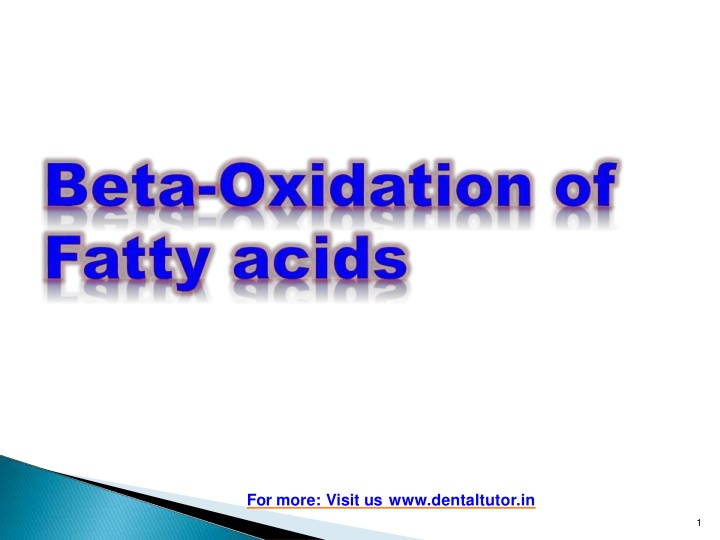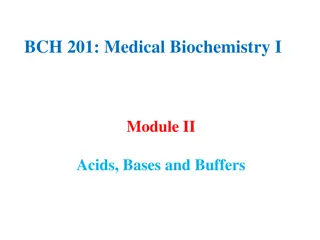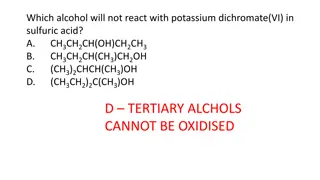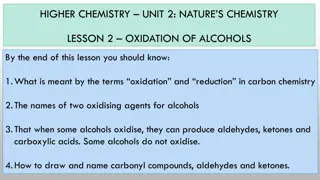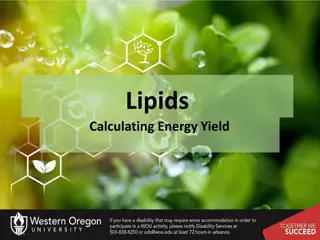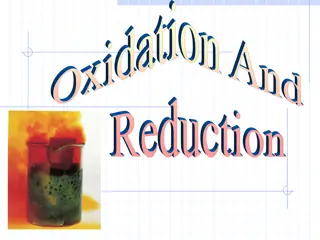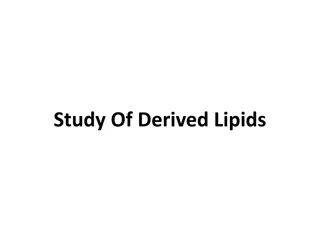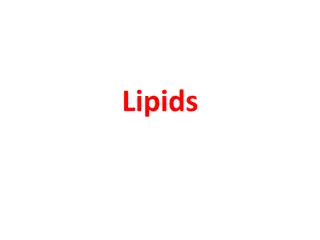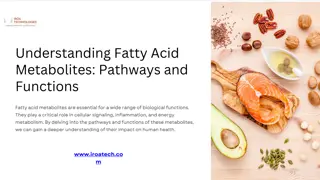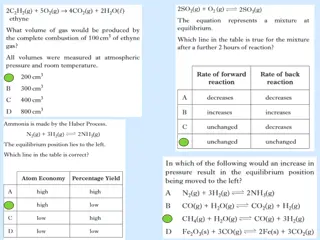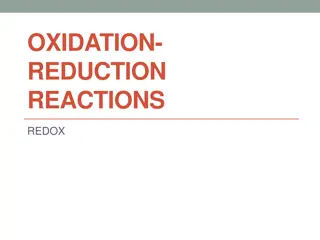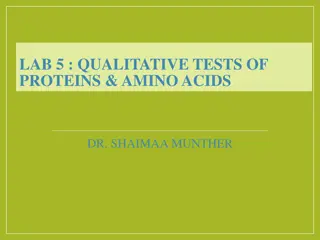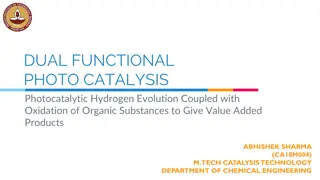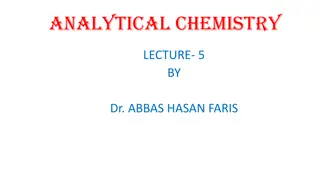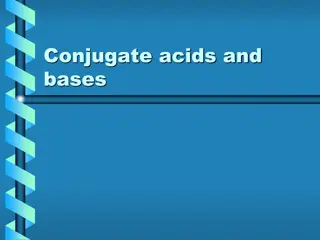Beta-Oxidation of Fatty Acids: Process and Significance
Beta-oxidation is the sequential removal of two-carbon fragments from fatty acids, generating acetyl-CoA for energy production. This essential metabolic pathway involves three stages: activation of fatty acids, transport into mitochondria, and oxidation in the mitochondrial matrix. The process requires ATP, coenzyme A, and specific enzymes for conversion. The impermeability of the inner mitochondrial membrane to fatty acids necessitates a carnitine shuttle system for their transport. Understanding beta-oxidation is crucial for comprehending energy metabolism and fatty acid utilization in the body.
Download Presentation

Please find below an Image/Link to download the presentation.
The content on the website is provided AS IS for your information and personal use only. It may not be sold, licensed, or shared on other websites without obtaining consent from the author.If you encounter any issues during the download, it is possible that the publisher has removed the file from their server.
You are allowed to download the files provided on this website for personal or commercial use, subject to the condition that they are used lawfully. All files are the property of their respective owners.
The content on the website is provided AS IS for your information and personal use only. It may not be sold, licensed, or shared on other websites without obtaining consent from the author.
E N D
Presentation Transcript
Beta-Oxidation may be defined as the oxidation of fatty acids on the beta-carbon atom. This results in the sequential removal of a two carbon fragment, acetyl CoA. For more: Visit us www.dentaltutor.in 2
Three stages Activation of fatty acids occurring in the cytosol Transport of fatty acids into mitochondria Beta-Oxidation proper in the mitochondrial matrix Fatty acids are oxidized by most of the tissues in the body. Brain, erythrocytes and adrenal medulla cannot utilize fatty acids for energy requirement. For more: Visit us www.dentaltutor.in 3
Fatty acids are activated to acyl CoA by thiokinases or acyl CoA synthetases The reaction occurs in two steps and requiresATP, coenzyme A andMg2+ Fatty acid reacts with ATP to form acyladenylate which then combines with coenzyme A to produce acylCoA. Two high energy phosphates are utilized, since ATP is converted to pyrophosphate (PPi). The enzyme inorganic pyrophosphafase hydrolyses PPi to phosphate. The immediate elimination of PPi makes this reaction totally irreversible. For more: Visit us www.dentaltutor.in 4
R-CH2-CH2- COO- Fatty Acid AT PPyrophosphatas PPi O Thiokinas e e PPi R-CH2-CH2-C-AMP Acyladenylate CoAS H AMP O R-CH2-CH2-C-CoA Acyl CoA For more: Visit us www.dentaltutor.in 5
The inner mitochondrial membrane is impermeable to fatty acids. A specialized carnitine carrier system (carnitine shuttle) operates to transport activated fatty acids from cytosol to the mitochondria. This occurs in four steps 1. Acyl group of acyl CoA is transferred tocarnitine ( -hydroxy -trimethyl aminobutyrate) For more: Visit us www.dentaltutor.in 6
catalyzed by carnitine acyltransferasIe (CAT) (present on the outer surface of inner mitochondrial membrane). 2.The acyl-carnitine is transported across the membrane to mitochondrial matrix by a specific carrier protein. 3.Carnitine acyl transferase ll (found on the inner surface of inner mitochondrial membrane) converts acyl-carnitine to acyl CoA. 4.The carnitine released returns to cytosol for reuse. For more: Visit us www.dentaltutor.in 7
Inner Mitochondrial Matrix Mitochondri al membrane Cytosol Carnitin e Carnitin e Acyl CoA Acyl CoA Carrier Protein CAT- I CAT-II Acyl Acyl CoASH Carnitine Carnitine CoASH For more: Visit us www.dentaltutor.in 8
Each cycle of -oxidation, liberating a two carbon unit-acetyl CoA, occurs in a sequence of four reactions 1. Oxidation 2. Hydration 3. Oxidation 4. Cleavage For more: Visit us www.dentaltutor.in 9
Acyl CoA undergoes dehydrogenation by an FAD-dependent flavoenzyme, acyl CoA dehydrogenase. A double bond is formed between and carbons (i.e., 2 and 3 carbons) 2.Hydration: Enoyl CoA hydratase brings about the hydration of the double bond to form - hydroxyacyl CoA. For more: Visit us www.dentaltutor.in 10
3.Oxidation -Hydroxyacyl CoAdehydrogenase catalyses the second oxidation and generates NADH. The product formed is -ketoacyl CoA. 4.Cleavage The final reaction in -oxidation is the liberation of a 2 carbon fragment, acetyl CoA from acyl CoA. This occurs by a thiolytic cleavage catalysed by -ketoacyl CoA thiolase (or thiolase). For more: Visit us www.dentaltutor.in 11
The new acyl CoA, containing two carbons less than the original, reenters the -oxidation cycle. The process continues till the fatty acid is completely oxidized. For more: Visit us www.dentaltutor.in 12
-Oxidation of fatty acids O R CH2 CH2 CH2 C O Fatty acid ATP CoASH Mg+2 Thiokinase ADP + PPi O R CH2 CH2 CH2 C SCoA Acyl CoA Cytosol Carnitine Transport system Mitochondria For more: Visit us www.dentaltutor.in 13
O R CH2 CH2 CH2 C SCoA Acyl CoA SIDS FAD Acyl CoA Dehydrogenase O 2ATP ----- ETC FADH2 R CH2 CH2 CH2 C SCoA Trans-enoyl CoA H2O Enoyl CoA Hydratase O OH R CH2 CH CH2 C SCoA - Hydroxyacyl CoA For more: Visit us www.dentaltutor.in 14
OH O R CH2 CH CH2 C SCoA - Hydroxyacyl CoA Acyl CoA NAD -Hydroxy Acyl CoA Dehydrogenase 3ATP ----- ETC NADH + H+ O O R CH2 C CH2 C SCoA - Ketoacyl CoA TCA Cycle Thiolase O O CH3 C SCoA Acetyl CoA R CH2 C SCoA Acyl CoA For more: Visit us www.dentaltutor.in 15
Oxidation of palmitoyl CoA Palmitoyl CoA + 7 CoASH + 7 FAD+ 7 NAD+ +7 H2O FADH2 + 7 NADH +7H+ Palmitoyl CoA undergoes 7 cycles of - oxidation to yield 8 acetyl CoA. 8 Acetyl CoA +7 Acetyl CoA can enter citric acid cycle and get completely oxidized to CO2 andH2O. For more: Visit us www.dentaltutor.in 16
Mechanism ATP yield I. - 0xidation 7 cycles 7 FADH2 [Oxidized by electron transport Chain (ETC) each FADH2 gives 2 ATP] 14 7 NADH (Oxidized by ETC, each NADH Liberate 3ATP) 21 II. From 8 Acetyl CoA Oxidized by citric acid cycle, each acetyl CoA provides 12 ATP 96 Total energy from one molecule of palmitoyl CoA 131 Energy utilized for activation (Formation of palmitoyl Co A) Net yield of oxidation of one molecule of palmitate -2 =129 For more: Visit us www.dentaltutor.in 17
Unexpected death of healthy infants, usually overnight Due to deficiency of medium chain acyl CoA dehydrogenase. Glucose is the principal source of energy, soon after eating or feeding babies. After a few hours, the glucose level and its utilization decrease and the rate of fatty acid oxidation must simultaneously increase to meet the energy needs. The sudden death in infants is due to a blockade in - oxidation caused by a deficiency in medium chain acyl CoA dehydrogenase (MCAD) For more: Visit us www.dentaltutor.in 18
This disease is characterized by severe hypoglycemia, vomiting, convulsions, coma and death. lt is caused by eating unriped ackee fruit which contains an unusual toxic amino acid, hypoglycinA. This inhibits the enzyme acyl CoA dehydrogenase and thus -oxidation of fatty acids is blocked, leading to various complications For more: Visit us www.dentaltutor.in 19
Abnormalities in transport of fatty acids into mitochondria & defects in oxidation leads to deficient energy production by oxidation of long chain fatty acids. Features: Hypoketotic hypoglycemia, hyperammonemia, skeletal muscle weakness & liver diseases. Acyl carnitine accumulates when the transferases or translocase is deficient. Dietary supplementation of carnitine improve the condition. For more: Visit us www.dentaltutor.in 20
Oxidation of odd chain fatty acids is similar to that of even chain fatty acids. At the end 3 carbon unit, propionyl CoA is produced. Propionyl CoA is converted into succinyl CoA. Succinyl CoA is an intermediate in TCAcycle So, propionyl CoA is gluconeogenic. For more: Visit us www.dentaltutor.in 21
Propionyl CoA is carboxylated to D-methyl malonyl CoA by a biotin dependent carboxylase. Biotin is B7 vitamin & ATP is utilized in this step. Recemase: Recemase acts upon D-methyl malonyl CoAto give L-methyl malonyl CoA. This reaction is essential for the entry of this compound into metabolic reactions of body. For more: Visit us www.dentaltutor.in 22
Mutase: Mutase catalyzes the conversion of L-methyl malonyl CoA (a branched chain compound) to succinyl CoA (a straight chain compound). Mutase is an vitamin B12 dependentenzyme. Succinyl CoA enters the TCA cycle, & converted into oxaloacetate, it is used for gluconeogenesis. Propionyl CoA is also derived from metabolism of valine & isoleucine. For more: Visit us www.dentaltutor.in 23
CH3 I CH2 I CO-S-CoA CH3 I Propionyl CoA carboxylase CO2 H - C- COO- I CO-S-CoA Biotin D-methyl malonyl CoA Propionyl CoA ADP + Pi ATP Methyl malonyl CoA recemase COO- I CH2 I CH2 I CO-S-CoA Succinyl CoA TCA CH3 I Methyl malonyl CoA mutase Vitamin B12 -OOC C - H I CO-S-CoA L - methyl malonyl CoA For more: Visit us www.dentaltutor.in 24
Propionyl CoA carboxylase deficiency: Characterized by propionic acidemia, ketoacidosis & developmental abnormalities. Methyl malonic aciduria: Two types of methyl malonic acidemias Due to deficiency of vitamin B12 Due to defect in the enzyme methyl malonyl CoA mutase or recemase. Accumulation of methyl malonic acid in the body. For more: Visit us www.dentaltutor.in 25
Methyl malonic acid is excreted into urine. Symptoms: Severe metabolic acidosis, damages the central nervous system & growth retardation. Fetal in early life. Treatment: Some patients respond to treatment with pharmacological doses of B12. For more: Visit us www.dentaltutor.in 26
Oxidation of fatty acids on -carbon atom is known as -oxidation. In this, removal of one carbon unit from the carboxyl end. Energy is not produced. No need of fatty acid activation & coenzymeA Hydroxylation occurs at -carbon atom. It is then oxidized to -keto acid. This, keto acid undergoes decarboxylation, yielding a molecule of CO2 & FA with one carbon atom less. For more: Visit us www.dentaltutor.in 27
Occurs in endoplasmic reticulum. Some FA undergo - oxidation in peroxisomes. - oxidation is mainly used for fatty acids that have a methyl group at the beta-carbon, which blocks beta- oxidation. Major dietary methylated fatty acid is phytanic acid. It is derived from phytol present in chlorophyll, milk & animal fats. For more: Visit us www.dentaltutor.in 28
Due to deficiency of the enzyme -hydroxylase (phytanic acid oxidase) oxidation does not occur. Phytanic acid does not converted into compound that can be degraded by beta oxidation. Phytanic acid accumulates in tissues. Symptoms: Severe neurological symptoms, polyneuropathy, retinitis pigmentosa, nerve deafness & cerebellar ataxia. Restricted dietary intake of phytanic acid (including milk-is a good source of phytanic acid) For more: Visit us www.dentaltutor.in 29
Minor pathway, takes place in microsomes. Catalyzed by hydroxylase enzymes involving NADPH & cytochrome P-450. Methyl (CH3) group is hydroxylated to CH2OH & subsequently oxidized with the help of NAD+ to COOH group to produce dicarboxylic acids. When -oxidation is defective & dicarboxylic acids are excreted in urine causing dicarboxylic aciduria. For more: Visit us www.dentaltutor.in 30
For more: Visit us www.dentaltutor.in 31
